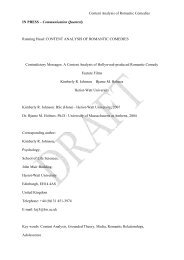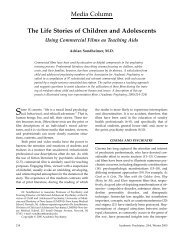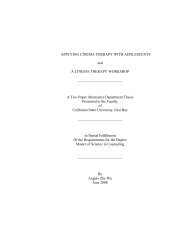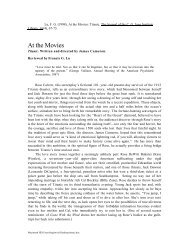Psychologists' Use of Motion Pictures in Clinical Practice - Reocities
Psychologists' Use of Motion Pictures in Clinical Practice - Reocities
Psychologists' Use of Motion Pictures in Clinical Practice - Reocities
Create successful ePaper yourself
Turn your PDF publications into a flip-book with our unique Google optimized e-Paper software.
Pr<strong>of</strong>essional Psychology: Research and <strong>Practice</strong>Copyright 2004 by the American Psychological Association2004, Vol. 35, No. 5, 535–541 0735-7028/04/$12.00 DOI: 10.1037/0735-7028.35.5.535Psychologists’ <strong>Use</strong> <strong>of</strong> <strong>Motion</strong> <strong>Pictures</strong> <strong>in</strong> Cl<strong>in</strong>ical <strong>Practice</strong>Georgios K. LampropoulosBall State UniversityNikolaos KazantzisMassey University and Waitemata District Health BoardCognitive Therapy CenterFrank P. DeaneUniversity <strong>of</strong> WollongongDo pr<strong>of</strong>essional psychologists use motion pictures <strong>in</strong> cl<strong>in</strong>ical practice? If so, do they consider motionpictures to have therapeutic value? Of 827 licensed practic<strong>in</strong>g psychologists, 67% reported the use <strong>of</strong>motion pictures to promote therapy ga<strong>in</strong>s. Most <strong>of</strong> these practitioners (88%) considered the use <strong>of</strong> motionpictures as effective <strong>in</strong> promot<strong>in</strong>g treatment outcome, and only a m<strong>in</strong>ority (1%) reported them aspotentially harmful. Compared with their psychodynamic counterparts, therapists practic<strong>in</strong>g with<strong>in</strong>eclectic–<strong>in</strong>tegrative, cognitive–behavioral, or humanistic frameworks were more likely to view or usemotion pictures as therapeutic tools. Psychologists provided <strong>in</strong>dividual evaluations <strong>of</strong> 27 motion picturesthat deal with a variety <strong>of</strong> mental health subjects, and overall they were characterized as “moderatelyhelpful.” Cl<strong>in</strong>ical applications and issues perta<strong>in</strong><strong>in</strong>g to us<strong>in</strong>g motion pictures <strong>in</strong> therapy are summarized.There is <strong>in</strong>creas<strong>in</strong>g <strong>in</strong>terest <strong>in</strong> the use <strong>of</strong> self-help materials, butrelatively little is known about psychologists’ actual use <strong>of</strong> selfhelpmaterials <strong>in</strong> cl<strong>in</strong>ical practice. Recent advances <strong>in</strong> self-helpmaterials (books and self-help groups) <strong>in</strong>clude the use <strong>of</strong> c<strong>in</strong>ematherapyor videowork, that is, the use <strong>of</strong> enterta<strong>in</strong>ment motionpictures for therapeutic purposes (Berg-Cross, Jenn<strong>in</strong>gs, & Baruch,1990; Hesley & Hesley, 1998; Solomon, 1995; Sharp, Smith, &GEORGIOS K. LAMPROPOULOS received his MA <strong>in</strong> cl<strong>in</strong>ical psychology fromthe University <strong>of</strong> Crete, Greece. He is a doctoral student <strong>in</strong> counsel<strong>in</strong>gpsychology at Ball State University, Muncie, Indiana, and a scholarshiprecipient <strong>of</strong> the Alexander S. Onassis Public Benefit Foundation, Athens,Greece. He is also an <strong>in</strong>tern at the Centre for Addiction and Mental Health,Mood and Anxiety Program, Toronto, Ontario, Canada. His research<strong>in</strong>terests <strong>in</strong>clude psychotherapy process and outcome research, psychotherapy<strong>in</strong>tegration, self-help, and psychotherapy tra<strong>in</strong><strong>in</strong>g.NIKOLAOS KAZANTZIS received his PhD <strong>in</strong> psychology from Massey University,New Zealand, where he currently holds an appo<strong>in</strong>tment as alecturer (equivalent assistant pr<strong>of</strong>essor). He is also a cl<strong>in</strong>ical psychologistand coord<strong>in</strong>ator <strong>of</strong> research at the Waitemata District Health Board CognitiveTherapy Center. His research program is focused on the role <strong>of</strong>therapeutic homework assignments <strong>in</strong> cognitive–behavioral therapy.FRANK P. DEANE received his PhD <strong>in</strong> psychology from Massey University,New Zealand. He is a pr<strong>of</strong>essor <strong>in</strong> psychology and director <strong>of</strong> the IllawarraInstitute for Mental Health at the University <strong>of</strong> Wollongong, Australia. Hisresearch <strong>in</strong>terests <strong>in</strong>clude help seek<strong>in</strong>g for mental health problems, use <strong>of</strong>homework <strong>in</strong> psychosocial <strong>in</strong>terventions, treatment adherence, and recoveryprocesses for recurr<strong>in</strong>g mental illness.THIS RESEARCH IS SUPPORTED <strong>in</strong> part by Grant 1157553216 and MasseyUniversity Research Award PR56786.1207 MURF, a grant from the IllawarraInstitute for Mental Health, University <strong>of</strong> Wollongong, and a grantfrom the Lyell Bussell Memorial Graduate Fund, Ball State University.CORRESPONDENCE CONCERNING THIS ARTICLE should be addressed to GeorgiosK. Lampropoulos, Department <strong>of</strong> Counsel<strong>in</strong>g Psychology, TC 622,Ball State University, Muncie, IN 47306. E-mail: g_lamp@hotmail.comCole, 2002). <strong>Motion</strong> pictures hold several advantages over otherself-help materials because they are typically more available, familiar,and accessible, and they <strong>of</strong>ten represent easy, quick, andpleasurable activities for clients (Hesley & Hesley, 1998). However,there is little <strong>in</strong>formation on the extent to which the generalpsychologist population uses motion pictures <strong>in</strong> cl<strong>in</strong>ical practiceand on which motion pictures are considered to have therapeuticvalue. The use <strong>of</strong> motion pictures <strong>in</strong> therapy may also vary as afunction <strong>of</strong> practitioners’ cl<strong>in</strong>ical experience, theoretical orientation,work sett<strong>in</strong>g, and other practice characteristics. The presentstudy was designed to provide data on us<strong>in</strong>g motion pictures <strong>in</strong>cl<strong>in</strong>ical practice.In the late 1970s Rhea Rub<strong>in</strong> provided a detailed account <strong>of</strong> therationale and benefits for the cl<strong>in</strong>ical use <strong>of</strong> the self-help materials,such as psychological books, poetry, and literature (Rub<strong>in</strong>, 1978a,1978b). The range <strong>of</strong> therapeutic self-help materials has s<strong>in</strong>ceexpanded to <strong>in</strong>clude client autobiographies, the Internet, and motionpictures (L’Abate, 2004; Norcross, 2000; Scog<strong>in</strong>, 2003a).Delphi polls <strong>of</strong> psychotherapy experts predicted that self-help andself-change would be among the cl<strong>in</strong>ical <strong>in</strong>terventions <strong>of</strong> the future(Norcross, Alford, & DeMichele, 1992; Norcross, Hedges, &Prochaska, 2002). This expansion is supported by a variety <strong>of</strong>socioeconomic and cl<strong>in</strong>ical factors (Norcross, 2000), <strong>in</strong>clud<strong>in</strong>g thestudy <strong>of</strong> client self-change with<strong>in</strong> and outside therapy (Bohart &Tallman, 1999; Prochaska & DiClemente, 1992).<strong>Motion</strong> pictures are not only narratives that transmit the valuesand ideas <strong>of</strong> our culture, but also a very popular and widespreadmethod <strong>of</strong> communication and expression. In treatment, moviescan be seen as therapeutic metaphors that can <strong>in</strong>troduce clients tomaterial that is sensitive or perceived as threaten<strong>in</strong>g (Hesley &Hesley, 1998; Heston & Kottman, 1997). Movie characters canessentially act as cotherapists for clients. In addition, Hesley andHesley (1998) described how therapists use motion pictures topromote therapeutic change by <strong>of</strong>fer<strong>in</strong>g hope and encouragement,535
536 LAMPROPOULOS, KAZANTZIS, AND DEANEdeepen<strong>in</strong>g emotion, provid<strong>in</strong>g role models, enhanc<strong>in</strong>g clientstrengths, refram<strong>in</strong>g problems, improv<strong>in</strong>g communication, andreprioritiz<strong>in</strong>g values. To these can be added the potential benefits<strong>of</strong> provid<strong>in</strong>g clients with support and acceptance for their conditionand facilitat<strong>in</strong>g emotional relief, <strong>in</strong>formation gather<strong>in</strong>g, problemawareness, and preparation for action. For example, the depiction<strong>of</strong> the struggle to overcome alcoholism <strong>in</strong> a relationship <strong>in</strong>When a Man Loves a Woman (Kerner, Avnet, & Mandoki, 1994)and the importance <strong>of</strong> a child’s welfare <strong>in</strong> a custody battle <strong>in</strong>Kramer vs. Kramer (Jaffe & Benton, 1979) are two well-knownmotion pictures that address important cl<strong>in</strong>ical issues. Indeed,there is a vast array <strong>of</strong> motion pictures that deal with abandonment,abuse, adoption, alcohol and drug use, death and dy<strong>in</strong>g, divorce,adolescence, family, vocation, friendship, gambl<strong>in</strong>g, eat<strong>in</strong>g problems,mental illness, physical illness, and sexuality. These materialshave been supported by an <strong>in</strong>creas<strong>in</strong>g number <strong>of</strong> practitionerrecommendations on how to use them <strong>in</strong> cl<strong>in</strong>ical practice (seeDermer & Hutch<strong>in</strong>gs, 2000; Hesley & Hesley, 1998, 2001;Norcross et al., 2000, 2003; Solomon, 1995, 2001).Evidence from experimental research has supported the assertionthat self-help materials can enhance therapeutic effectiveness.Meta-analytic reviews have demonstrated that certa<strong>in</strong> self-helpprograms are superior to placebo and even equally effective withtherapist-facilitated <strong>in</strong>terventions for a variety <strong>of</strong> psychologicalproblems (Cuijpers, 1997; Gould & Clum, 1993; Marrs, 1995;Scog<strong>in</strong>, 2003b; Scog<strong>in</strong>, Bynum, Stephens, & Calhoon, 1990).However, few studies have assessed the extent to which self-helpmaterials are used <strong>in</strong> cl<strong>in</strong>ical practice. Surveys <strong>of</strong> practitioners’ use<strong>of</strong> self-help books and client autobiographies have shown that asubstantial percentage <strong>of</strong> cl<strong>in</strong>icians have used them for therapeuticpurposes (Clifford, Norcross, & Sommer, 1999; Marx, Royalty,Gyorky, & Stern, 1992; Norcross et al., 2000, 2003; Starker,1988).Norcross et al. (2000) provided prelim<strong>in</strong>ary data on the cl<strong>in</strong>icaluse <strong>of</strong> movies from 401 members <strong>of</strong> the cl<strong>in</strong>ical and counsel<strong>in</strong>gpsychology divisions <strong>of</strong> the American Psychological Association(APA). The researchers reported that almost one half <strong>of</strong> respondentsrecommended movies to their clients and that 68% <strong>of</strong> thesepractitioners found them helpful (2% perceived them as harmful).Norcross et al. also obta<strong>in</strong>ed quality rat<strong>in</strong>gs for a list <strong>of</strong> motionpictures across 20 problem areas, which they have s<strong>in</strong>ce updatedwith the evaluations <strong>of</strong> additional titles from a subsequent survey<strong>of</strong> 316 cl<strong>in</strong>ical and counsel<strong>in</strong>g psychologists (Norcross et al.,2003). Despite these emerg<strong>in</strong>g data on practice, there are nopublished reports about the methods <strong>of</strong> motion picture use, orwhether practitioners with different levels <strong>of</strong> experience, theoreticalorientation, work sett<strong>in</strong>g, and other characteristics differ <strong>in</strong>their cl<strong>in</strong>ical use <strong>of</strong> motion pictures. Similarly, there are no publishedreports on the specific motion pictures most commonlyrecommended to clients. This project provides such <strong>in</strong>formation bysurvey<strong>in</strong>g a sample <strong>of</strong> APA practitioners. 1The Movies ProjectConsistent with prior surveys <strong>of</strong> psychologists’ use and evaluation<strong>of</strong> self-help books and autobiographies for mental healthclients (Clifford et al., 1999; Marx et al., 1992; Starker, 1988), weaimed to provide prelim<strong>in</strong>ary data that could assist practitioners <strong>in</strong>evaluat<strong>in</strong>g and us<strong>in</strong>g popular enterta<strong>in</strong>ment motion pictures <strong>in</strong>therapy. Do psychologists believe that motion pictures can betherapeutic and used <strong>in</strong> treatment? Have they ever discussed orrecommended a movie to a client? If so, <strong>in</strong> what way have theyused it <strong>in</strong> session and what were the results? Are they familiar withsome <strong>of</strong> the commonly used motion pictures <strong>in</strong> cl<strong>in</strong>ical practice,and would they recommend them to other practitioners?The present study obta<strong>in</strong>ed <strong>in</strong>formation on demographics, theoreticalorientation, attitudes, evaluation, patterns <strong>of</strong> cl<strong>in</strong>ical use <strong>of</strong>motion pictures, and rat<strong>in</strong>gs <strong>of</strong> specific motion pictures. The latterlist was developed on the basis <strong>of</strong> the lists <strong>of</strong> motion picturesdescribed <strong>in</strong> the two major guidebooks on c<strong>in</strong>ematherapy (Hesley& Hesley; 1998; Solomon, 1995), from which we chose only thosetitles that were also recommended by the mental health pr<strong>of</strong>essionals<strong>in</strong> a small local survey by Dermer and Hutch<strong>in</strong>gs (2000).This procedure was used to ensure title recognition and cl<strong>in</strong>ical use<strong>of</strong> motion pictures <strong>in</strong> our survey. The f<strong>in</strong>al list comprised 27 titlesthat covered a variety <strong>of</strong> problems and disorders.In September 2000, a cover letter, the survey, and a postage-paidreturn envelope were mailed to 3,000 randomly selected members<strong>of</strong> the APA. The mail<strong>in</strong>g labels were provided by the APA with theconstra<strong>in</strong>ts that psychologists (a) resided <strong>in</strong> the United States, (b)were licensed practitioners, and (c) had <strong>in</strong>dicated that the provision<strong>of</strong> health and mental health services was their primary activity <strong>in</strong>their primary or secondary work sett<strong>in</strong>g. Two weeks later a rem<strong>in</strong>dercard was sent to all participants, and 1 month later a secondsurvey was mailed to 1,200 randomly selected participants fromthe orig<strong>in</strong>al 3,000. The return rate <strong>of</strong> 28% yielded 840 returns anda total <strong>of</strong> 827 usable returns. All responses were completelyanonymous. The return envelopes were not coded and were destroyedon receipt.To evaluate the representativeness <strong>of</strong> the respondents, we comparedtheir characteristics with those <strong>of</strong> the <strong>in</strong>itial sample <strong>of</strong> 3,000provided by the APA, as well as those <strong>of</strong> the APA members whoprovide mental health services (provided by the APA researchdepartment). The respondents had almost identical characteristicswith both <strong>of</strong> these groups <strong>in</strong> terms <strong>of</strong> gender, age, race–ethnicity,highest degree obta<strong>in</strong>ed, number <strong>of</strong> years s<strong>in</strong>ce degree, and area <strong>of</strong>highest academic qualification. Forty-n<strong>in</strong>e percent <strong>of</strong> respondentswere men and 95% <strong>of</strong> respondents were Caucasian. The mean age<strong>of</strong> respondents was 52.43 years (SD 9.64). In terms <strong>of</strong> pr<strong>of</strong>essionaldegree, 84% had earned a PhD, 9% had earned a PsyD, 4%had earned an EdD, and 3% had earned another advanced degree.Respondents had been out <strong>of</strong> graduate school an average <strong>of</strong> 18.60years (SD 9.51). Seventy-six percent <strong>of</strong> respondents identifiedwith cl<strong>in</strong>ical psychology, 18% with counsel<strong>in</strong>g psychology, 2%with school psychology, and 4% with “other.” Although the samplehad similar characteristics to the <strong>in</strong>itial APA-provided sampleand was similar to recent practitioner surveys (i.e., 30% <strong>in</strong> Addis& Krasnow, 2000), the f<strong>in</strong>al response rate <strong>of</strong> 28% does suggestthat the f<strong>in</strong>d<strong>in</strong>gs should be considered <strong>in</strong>dicative and prelim<strong>in</strong>ary.Seventy-four percent <strong>of</strong> respondents reported <strong>in</strong>dependent practiceas their primary employment sett<strong>in</strong>g, and 94% <strong>of</strong> respondents<strong>in</strong>dicated direct patient contact as their primary pr<strong>of</strong>essional activity.The mean percentage <strong>of</strong> respondents’ annual caseload seen<strong>in</strong> different therapy formats was 72% (SD 19%) for <strong>in</strong>dividual1 The results <strong>of</strong> the Norcross et al. (2000) study were not available at thetime we were plann<strong>in</strong>g and conduct<strong>in</strong>g the data collection for this project.
PSYCHOLOGISTS’ USE OF MOTION PICTURES537therapy, 16% (SD 12%) for couples therapy, 14% (SD 15%)for family therapy, and 10% (SD 14%) for group therapy.Respondents reported treat<strong>in</strong>g mostly adults (68% <strong>of</strong> yearly caseload;SD 25%), followed by adolescents (17%; SD 15%),children (17%; SD 18%), older adults (12%; SD 12%), and<strong>in</strong>fants (1%; SD 4%). In terms <strong>of</strong> primary theoretical orientation,respondents self-identified with cognitive–behavioral therapy(41%), psychodynamic–analytic therapy (25%), existential–humanistic therapy (8%), <strong>in</strong>terpersonal therapy (8%), family systemstherapy (4%), behavioral therapy (2%), social learn<strong>in</strong>g therapy(1%), and other therapies (<strong>in</strong>tegrative–eclectic; 12%). Theranges and percentages <strong>of</strong> theoretical orientations were consistentwith a survey <strong>of</strong> APA Division 12 (Cl<strong>in</strong>ical Psychology) members(Norcross, Karg, & Prochaska, 1997).Attitudes and <strong>Use</strong> <strong>of</strong> <strong>Motion</strong> <strong>Pictures</strong> <strong>in</strong> Cl<strong>in</strong>ical <strong>Practice</strong>Sixty-seven percent <strong>of</strong> respond<strong>in</strong>g practic<strong>in</strong>g psychologists eitheragreed (54%) or strongly agreed (13%) that “quality enterta<strong>in</strong>mentmotion pictures that deal with psychological issues canbe beneficial and could be used for therapeutic purposes (e.g.,awareness rais<strong>in</strong>g, model<strong>in</strong>g behavior, and client <strong>in</strong>spiration).”Twenty-five percent <strong>of</strong> respondents rema<strong>in</strong>ed neutral, and only 8%<strong>of</strong> respondents <strong>in</strong>dicated they either disagreed or strongly disagreedwith the above statement (M response 3.67, SD 0.90,on a Likert-type scale with anchors 1 strongly disagree and 5 strongly agree).We were <strong>in</strong>terested <strong>in</strong> exam<strong>in</strong><strong>in</strong>g whether theoretical orientationwas related to the perceived therapeutic value <strong>of</strong> motion picturesfor two reasons. First, assign<strong>in</strong>g motion pictures <strong>in</strong> therapy hasbeen described as a type <strong>of</strong> homework assignment (Hesley &Hesley, 1998), and homework has been traditionally associatedwith the practice <strong>of</strong> cognitive–behavioral therapy compared withother therapies (Blagys & Hilsenroth, 2002; Kazantzis & Deane,1999). Second, the use <strong>of</strong> motion pictures as self-help adjuncts totherapy is consistent with the tenets <strong>of</strong> humanistic therapy, whereclients are seen as active self-healers (Bohart & Talman, 1999).Therefore, we recoded theoretical orientation <strong>in</strong>to five categories(cognitive–behavioral, humanistic–existential, psychodynamic–analytic, <strong>in</strong>terpersonal–family systems, and eclectic–<strong>in</strong>tegrative)and conducted an analysis <strong>of</strong> variance (ANOVA) to exam<strong>in</strong>edifferences among practitioners <strong>of</strong> major theoretical orientations.For the potential value <strong>of</strong> us<strong>in</strong>g motion pictures <strong>in</strong> therapy, therewere statistically significant differences among respondents <strong>of</strong>different theoretical orientations, F(4, 760) 4.70, p .001. ATukey post hoc test revealed that cognitive–behavioral (M 3.76,SD 0.87) and eclectic–<strong>in</strong>tegrative (M 3.81, SD 0.77)therapists more frequently considered motion pictures as therapeutictools than did psychodynamic–analytic therapists (M 3.44,SD 0.95), p .01.When asked about the natural occurrence <strong>of</strong> <strong>in</strong>-session discussions<strong>of</strong> motion pictures, 90% <strong>of</strong> respondents reported that theyhad discussed a motion picture with a client <strong>in</strong> therapy withoutnecessarily recommend<strong>in</strong>g it. Sixty-seven percent <strong>of</strong> respondentsreported that they had recommended a motion picture to a client,a substantially higher proportion than the 46% reported <strong>in</strong> theNorcross et al. (2000) study.Practitioners who had recommended a motion picture to a clientwere asked to check up to four options describ<strong>in</strong>g the method theyused for <strong>in</strong>corporat<strong>in</strong>g motion pictures <strong>in</strong> therapy. Of the 536respondents who recommended a motion picture to a client, 95%discussed the movie <strong>in</strong> session, 53% recommended the movie butdid not discuss it <strong>in</strong> session, 29% assigned therapeutic homeworkrelated to the movie, and 5% watched the movie or parts <strong>of</strong> it withthe client <strong>in</strong> session. The percentages reported for the use <strong>of</strong> eachmethod were comparable with those reported for self-help books(Marx et al., 1992) and autobiographies <strong>of</strong> mental health clients(Clifford et al., 1999), suggest<strong>in</strong>g that the <strong>in</strong>-session use <strong>of</strong> motionpictures may be similar to other adjunctive self-help materials.A chi-square analysis revealed significant differences amongpractitioners <strong>of</strong> major theoretical orientations <strong>in</strong> their use <strong>of</strong> motionpictures, 2 (4, N 772) 35.48, p .001. More specifically,87% <strong>of</strong> eclectic–<strong>in</strong>tegrative practitioners had recommended motionpictures as a therapy adjunct, whereas 79% <strong>of</strong> humanistic–existential practitioners, 65% <strong>of</strong> <strong>in</strong>terpersonal–systemic practitioners,65% <strong>of</strong> cognitive–behavioral practitioners, and 54% <strong>of</strong>psychodynamic–analytic practitioners had recommended motionpictures. Additional chi-square tests between pairs <strong>of</strong> theoreticalorientations were conducted, with alpha set at p .01 for all tests(to reduce the likelihood <strong>of</strong> Type I error). These tests revealed that(a) eclectic–<strong>in</strong>tegrative therapists were more likely to recommendmovies compared with practitioners with <strong>in</strong>terpersonal, cognitive–behavioral, and psychodynamic orientations, and (b) humanistic–existential therapists were more likely to recommend movies thantheir psychodynamic–analytic colleagues.Statistical tests were also conducted to exam<strong>in</strong>e differences <strong>in</strong>use <strong>of</strong> motion pictures <strong>in</strong> terms <strong>of</strong> the follow<strong>in</strong>g five variables <strong>of</strong><strong>in</strong>terest: practitioners’ gender, cl<strong>in</strong>ical experience, primary employmentsett<strong>in</strong>g (private practice vs. other), type <strong>of</strong> academicdegree (PhD vs. PsyD), and area <strong>of</strong> academic degree (cl<strong>in</strong>ical vs.counsel<strong>in</strong>g psychology). Male respondents were slightly morelikely to have recommended a movie to a client than women (72%vs. 60%), 2 (2, N 802) 12.34, p .001. Psychologists <strong>in</strong>private practice were also more likely to have recommended amovie to a client compared with those who reported a differentprimary employment sett<strong>in</strong>g (70% vs. 58%), 2 (2, N 791) 10.12, p .001. In terms <strong>of</strong> cl<strong>in</strong>ical experience, psychologists whohad recommended a motion picture to a client had more years <strong>of</strong>cl<strong>in</strong>ical practice (M 21.41, SD 9.08) than their colleagues whohad never recommended a movie (M 19.01, SD 8.70),t(797) 3.58, p .001. However, the use <strong>of</strong> motion pictures wasnot significantly different among those who were PhD versusPsyD tra<strong>in</strong>ed or between those tra<strong>in</strong>ed <strong>in</strong> cl<strong>in</strong>ical or counsel<strong>in</strong>gdiscipl<strong>in</strong>es.To survey the perceived therapeutic effects <strong>of</strong> motion pictures asa therapy adjunct, we asked psychologists to evaluate their ownexperience with us<strong>in</strong>g motion pictures <strong>in</strong> treatment on a Likerttypescale with anchors <strong>of</strong> 1 (very harmful) to5(very helpful).Seventy-six percent <strong>of</strong> respondents rated the effects as somewhathelpful and an additional 12% as very helpful, whereas 11% didnot perceive any effects and only 1% rated them as somewhatharmful (and none rated them as very harmful).Rat<strong>in</strong>gs <strong>of</strong> Therapeutic Value for Specific <strong>Motion</strong> <strong>Pictures</strong>With the goal <strong>of</strong> provid<strong>in</strong>g prelim<strong>in</strong>ary data for practitionersregard<strong>in</strong>g the perceived value <strong>of</strong> recommend<strong>in</strong>g particular motionpictures <strong>in</strong> treatment, we provided participants with the list <strong>of</strong> 27
538 LAMPROPOULOS, KAZANTZIS, AND DEANEmotion pictures. Table 1 presents motion pictures’ titles, years <strong>of</strong>release, and ma<strong>in</strong> psychological–therapeutic subjects. The latterissue was not always clear-cut because most <strong>of</strong> these motionpictures dealt with a variety <strong>of</strong> subjects, and descriptions werebased on a review <strong>of</strong> different sources (i.e., Dermer & Hutch<strong>in</strong>gs,2000; Hesley & Hesley; 1998; Solomon, 1995).Participants who recommend motion pictures (n 536) <strong>in</strong>dicatedwhether they had seen each movie, with responses rang<strong>in</strong>gfrom 27 (5%) to 501 (93%) respondents for the most popularmovie (see Table 1). The therapeutic quality <strong>of</strong> each movie fortreatment purposes was then rated on the follow<strong>in</strong>g scale: –2 extremely bad (this movie exemplified the worst <strong>of</strong> these type <strong>of</strong>motion pictures); –1 moderately bad (not a good movie, mayprovide mislead<strong>in</strong>g or <strong>in</strong>accurate <strong>in</strong>formation); 0 neutral (anaverage movie <strong>of</strong> this type); 1 moderately good (provides good<strong>in</strong>sight, can be helpful); 2 extremely good (outstand<strong>in</strong>g, highlyrecommended). This scale was based on those used <strong>in</strong> similarstudies <strong>of</strong> self-help books (Santrock, M<strong>in</strong>nett, & Campbell, 1994)and mental health client autobiographies (Clifford et al., 1999).Table 1 presents the means and standard deviations <strong>of</strong> therapeuticquality rat<strong>in</strong>gs for the 27 movie titles. Movie rat<strong>in</strong>gs rangedfrom 0.29 to 1.33 for the most valuable motion pictures, which arepresented <strong>in</strong> ranked order. Overall, these specific motion pictureswere considered to be moderately helpful, and none <strong>of</strong> themreceived negative mean rat<strong>in</strong>gs. Practitioners were also given theoption to cite and evaluate their own motion pictures at the end <strong>of</strong>our prepared list, <strong>in</strong> a response choice marked as “other.”Respondents who recommend motion pictures (n 536) also<strong>in</strong>dicated which <strong>of</strong> the listed motion pictures they had recommendedto a client, with the number <strong>of</strong> therapists hav<strong>in</strong>g recommendedeach title rang<strong>in</strong>g from 3 to 188 (see Table 1). As a seconddescriptive analysis <strong>of</strong> these data, the percentage <strong>of</strong> the sample thathad viewed and subsequently used a movie <strong>in</strong> therapy can be usedto <strong>in</strong>dicate how “recommended” a movie might be. The highestpercentage was for Ord<strong>in</strong>ary People (41% <strong>of</strong> the sample whoviewed it used it <strong>in</strong> therapy), which also received the highestquality rat<strong>in</strong>g. The proportion <strong>of</strong> therapists us<strong>in</strong>g any specificmovie ranged between 41% and 11%. Some <strong>in</strong>frequently seenmotion pictures may be used relatively frequently by the smallnumber <strong>of</strong> therapists who have seen them (e.g., Under the Influence,19 <strong>of</strong> 71, or 27%, used it). These data may provide prelim<strong>in</strong>aryguidel<strong>in</strong>es to help cl<strong>in</strong>icians select and assess the therapeuticquality <strong>of</strong> specific motion pictures.Summary and Implications for <strong>Practice</strong>Our study attempted to clarify cl<strong>in</strong>icians’ attitudes and patterns<strong>of</strong> use <strong>of</strong> motion pictures for therapeutic purposes and provideTable 1Frequency <strong>of</strong> Respondents (n 536) Who Personally Viewed and Therapeutically <strong>Use</strong>d <strong>Motion</strong> <strong>Pictures</strong> and Mean Rat<strong>in</strong>gs <strong>of</strong> TheirTherapeutic QualityViewed <strong>Use</strong>d Therapeutic quality<strong>Motion</strong> picture (year and ma<strong>in</strong> subject)n n/% M SD n RankOrd<strong>in</strong>ary People (Schwary & Redford, 1980; multigenerational issues, loss) 453 188/41 1.33 0.72 412 1Philadelphia (Saxon & Demme, 1993; AIDS and prejudice) 342 68/20 1.17 0.80 307 2The Great Sant<strong>in</strong>i (Pratt & Carl<strong>in</strong>o, 1979; father–son relationship, abuse) 252 89/35 1.14 0.85 227 3On Golden Pond (Gilbert & Rydell, 1981; ag<strong>in</strong>g and relationships) 471 126/27 1.14 0.76 422 4Trip to Bountiful (Vanwagenen, Forte, & Masterson, 1985; age and ageism) 198 40/20 0.97 0.77 179 5My Life (Lowry & Rub<strong>in</strong>, 1993; term<strong>in</strong>al illness and dy<strong>in</strong>g) 84 21/25 0.94 0.85 83 6Kramer vs. Kramer (R. C. Jaffe & Benton, 1979; divorce and custody) 462 97/21 0.93 0.81 409 7Dad (Kennedy, Marshall, Spielberg, & Goldberg, 1989; ag<strong>in</strong>g and family) 78 15/19 0.91 0.64 75 8Dead Poets Society (Haft, Witt, Thomas, & Weir, 1989; adolescence, family issues) 453 105/23 0.85 0.76 402 9When a Man Loves a Woman (Kerner, Avnet, & Mandoki, 1994; alcoholism) 184 47/26 0.84 0.89 170 10Terms <strong>of</strong> Endearment (Brooks, 1983; term<strong>in</strong>al illness) 436 77/18 0.84 0.85 384 11Parenthood (Grazer & Howard, 1989; parent–child relationships) 192 44/23 0.78 0.82 172 12Steel Magnolias (Stark & Ross, 1989; friendship, grief) 381 80/21 0.77 0.80 342 13One Flew Over the Cuckoo’s Nest (Douglas, Zaentz, & Forman, 1975; mental health) 501 116/23 0.76 1.04 447 14The Accused (S. R. Jaffe, Lans<strong>in</strong>g, & Kaplan, 1988; sexual assault) 152 23/15 0.76 0.95 138 15Under the Influence (Greene & Carter, 1986; alcoholism <strong>in</strong> the family) 71 19/27 0.75 0.77 71 16It’s a Wonderful Life (Capra, 1946; mean<strong>in</strong>g <strong>in</strong> life, suicide) 422 77/18 0.74 0.84 368 17Four Seasons (Bregman & Alda, 1981; divorce and remarriage) 232 34/15 0.67 0.79 212 18How to Make an American Quilt (Pilsbury, Sanford, & Moorhouse, 1995; <strong>in</strong>timacy) 136 18/13 0.67 0.61 121 19Like Water for Chocolate (Arau, 1993; family <strong>of</strong> orig<strong>in</strong>) 283 53/19 0.64 0.78 250 20Forest Gump (F<strong>in</strong>erman, Starkey, Tisch, & Zemeckis, 1994; mental challenges, label<strong>in</strong>g) 475 87/18 0.64 0.86 427 21The Big Chill (Kasdan, 1983; friendship, grief) 400 52/13 0.59 0.75 356 22Nuts (Corman, Schwartz, Streisand, & Ritt, 1987; sexual abuse) 186 34/18 0.54 0.99 174 23Bye, Bye Love (Goldberg, Hall, & Weisman, 1995; divorce) 27 3/11 0.37 0.79 27 24Dolores Claiborne (Mulvehill & Hackford, 1995; violence and sexual abuse) 153 17/11 0.34 0.91 142 25War <strong>of</strong> the Roses (Brooks, Milchan, & DeVito, 1989; conflict resolution) 352 65/18 0.29 1.18 315 26Pr<strong>in</strong>ce <strong>of</strong> Tides (Karsch & Streisand, 1991; sexual abuse) 397 82/21 0.29 1.32 362 27Note. Viewed number <strong>of</strong> therapists who <strong>in</strong>dicated they had personally viewed the movie. <strong>Use</strong>d number <strong>of</strong> therapists who <strong>in</strong>dicated they had usedthe movie for therapeutic purposes with clients. % used percentage <strong>of</strong> therapists who had used the movie from those who had viewed. Therapeuticquality rat<strong>in</strong>gs <strong>of</strong> perceived quality <strong>of</strong> the movie for therapeutic purposes (scale ranged from 2 extremely bad to 2 extremely good).
PSYCHOLOGISTS’ USE OF MOTION PICTURES539pilot data on the usefulness <strong>of</strong> specific motion pictures that dealwith psychological subjects. Overall, the f<strong>in</strong>d<strong>in</strong>gs are consistentwith those <strong>of</strong> Norcross et al. (2000) <strong>in</strong> that the majority <strong>of</strong> respond<strong>in</strong>gpsychologists have at some po<strong>in</strong>t discussed a movie <strong>in</strong>session, have positive attitudes toward motion pictures, and usemotion pictures <strong>in</strong> cl<strong>in</strong>ical practice. These prelim<strong>in</strong>ary f<strong>in</strong>d<strong>in</strong>gsalso suggest that motion pictures are almost as popular and helpfulas self-help books, at least accord<strong>in</strong>g to practitioners’ reports (seealso Norcross et al., 2000). However, a higher percentage <strong>of</strong>respondents <strong>in</strong> the present study (67%) had recommended a motionpicture to a client than <strong>in</strong> the Norcross et al. study (46%).Consistent with this, 88% <strong>in</strong> the present study considered the use<strong>of</strong> motion pictures to be helpful <strong>in</strong> therapy, whereas a lowerproportion (68%) rated them as helpful <strong>in</strong> the Norcross et al. study.These differences may be due to our sample hav<strong>in</strong>g more privatepractitioners compared with Norcross et al. (74% and 41%, respectively).Private practitioners seemed to be more will<strong>in</strong>g torecommend movies to their clients, as was also the case withself-help books (see Marx et al., 1992). Similar to the attitudestoward self-help books (Campbell & Smith, 2003), eclectic–<strong>in</strong>tegrative, cognitive–behavioral, and humanistic therapists weremore likely to view or use motion pictures as therapeutic toolscompared with psychodynamic–analytic therapists.Given such common use and the perceived value <strong>of</strong> motionpictures <strong>in</strong> therapy, there rema<strong>in</strong>s a need for research to quantifythe effects on psychotherapy processes and subsequent outcomes.However, because it may be unrealistic to expect that specificstudies will be conducted <strong>in</strong> the near future for each motion pictureas a therapeutic tool, it has been suggested that practitioners couldexplore the cl<strong>in</strong>ical use <strong>of</strong> films that have already been positivelyevaluated and recommended by hundreds <strong>of</strong> therapists (Norcross,2003). The results <strong>of</strong> the present study, together with the Norcrosset al. (2000, 2003) studies have provided prelim<strong>in</strong>ary rat<strong>in</strong>gs on theperceived value <strong>of</strong> several specific motion pictures that cover avariety <strong>of</strong> problems. It is notable that the majority <strong>of</strong> the motionpictures listed <strong>in</strong> this study were evaluated positively by practitioners<strong>in</strong> the present study. At the very least, these f<strong>in</strong>d<strong>in</strong>gs can beused as a prelim<strong>in</strong>ary cl<strong>in</strong>ical resource for select<strong>in</strong>g and us<strong>in</strong>gmotion pictures <strong>in</strong> cl<strong>in</strong>ical practice.Although some practitioners described the use <strong>of</strong> motion picturesmore than others, our data suggest that practitioners <strong>of</strong> alldifferent orientations and therapeutic modalities have used them ascl<strong>in</strong>ical tools. Practitioners’ responses <strong>in</strong>cluded a variety <strong>of</strong> <strong>in</strong>sessionuses <strong>of</strong> films, from simply discuss<strong>in</strong>g a film <strong>in</strong> session, toassign<strong>in</strong>g homework related to it, or even watch<strong>in</strong>g parts <strong>of</strong> it withthe client. <strong>Motion</strong> pictures can be useful therapy assignments,because their accessibility, familiarity, brevity, and enterta<strong>in</strong>mentvalue can spark client curiosity, build therapeutic rapport, andenhance homework compliance (Hesley & Hesley, 2001). However,therapeutic view<strong>in</strong>g is different from enterta<strong>in</strong>ment, <strong>in</strong> that itfocuses on the analysis <strong>of</strong> movie characters, their relationships,and behaviors and strives for client <strong>in</strong>sight through consciousidentification with the characters (Hesley & Hesley, 2001). Theevaluations <strong>of</strong> movies provided by the present study can assistselection, but we also recommend consult<strong>in</strong>g other availablesources to obta<strong>in</strong> additional cl<strong>in</strong>ical guidel<strong>in</strong>es with suggestions <strong>of</strong>specific movies for specific problems (e.g., Dermer & Hutch<strong>in</strong>gs,2000; Hesley & Hesley, 1998, 2001; Norcross et al., 2000, 2003;Solomon, 1995, 2001). Alternatively, <strong>in</strong>terested cl<strong>in</strong>icians can readactual cases <strong>of</strong> c<strong>in</strong>ematherapy (e.g., Heston & Kottman, 1997;Wedd<strong>in</strong>g & Niemiec, 2003) or even analyses <strong>of</strong> specific movietitles from different theoretical orientations (e.g., Cocks, 1991;Paden-Levy, 2000).The follow<strong>in</strong>g summary <strong>of</strong> general recommendations and cautionsare <strong>of</strong>fered to cl<strong>in</strong>icians who want to <strong>in</strong>tegrate c<strong>in</strong>ematherapy<strong>in</strong>to their cl<strong>in</strong>ical practice.1. Therapists should carefully consider who is and who is not agood candidate for the therapeutic use <strong>of</strong> motion pictures. Someprerequisites <strong>in</strong>clude at least moderate client function<strong>in</strong>g, client’s<strong>in</strong>terest and enjoyment <strong>in</strong> watch<strong>in</strong>g movies, and client’s ability tounderstand the movie. The age <strong>of</strong> the client, degree <strong>of</strong> impairment,as well as ability to dist<strong>in</strong>guish between fantasy and reality areimportant considerations. In addition, cultural and disability issuesshould be considered, and special caution is advised for clientswith severe trauma or violence issues (Dermer & Hutch<strong>in</strong>gs, 2000;Hesley & Hesley, 1998, 2001; Schulenberg, 2003).2. Therapists should choose the tim<strong>in</strong>g <strong>of</strong> the <strong>in</strong>tervention andassign a movie that is appropriate for client’s problems. Movies areused as therapeutic tools for specific purposes and should be well<strong>in</strong>tegrated <strong>in</strong> the therapeutic process, case formulation, and treatmentplan. Us<strong>in</strong>g only one movie at a time is preferred to maximizethe benefit <strong>of</strong> the experience and not overwhelm the client(Hesley & Hesley, 1998, 2001; Solomon, 1995; Sharp et al., 2002;Schulenberg, 2003).3. Movie selection criteria <strong>in</strong>clude choos<strong>in</strong>g titles that clientsenjoy or are familiar with and those recommended by other therapists.Consider<strong>in</strong>g a client’s <strong>in</strong>put and build<strong>in</strong>g on a client’sprevious movie-view<strong>in</strong>g experience may also <strong>in</strong>crease cooperationwith the assignment and the client’s benefit from it (Hesley &Hesley, 1998, 2001; Schulenberg, 2003).4. Desirable movie characteristics <strong>in</strong>clude the ability to <strong>in</strong>spireand evoke emotions, the depiction <strong>of</strong> characters solv<strong>in</strong>g problems,and, generally, <strong>of</strong> appropriate role models. It is preferable thatclients have similar demographics, values, and lifestyles withcharacters <strong>in</strong> the assigned movies, so they can better relate (Hesley& Hesley, 1998, 2001; Heston & Kottman, 1997).5. Therapists should view a movie before assign<strong>in</strong>g it to a clientand have a clear rationale for do<strong>in</strong>g so. Cl<strong>in</strong>icians should firstnormalize the exercise and expla<strong>in</strong> it to clients. This <strong>in</strong>cludesexpla<strong>in</strong><strong>in</strong>g expectations, identify<strong>in</strong>g the characters the clientshould focus on, and giv<strong>in</strong>g specific movie-view<strong>in</strong>g <strong>in</strong>structions(e.g., watch focused, pause and replay important scenes, keepnotes <strong>of</strong> <strong>in</strong>sights and emotions, and permission to turn the movie<strong>of</strong>f). In addition, therapists should discuss any scenes that may be<strong>of</strong>fensive or problematic ahead <strong>of</strong> time and address any clientconcerns (Dermer & Hutch<strong>in</strong>gs, 2000; Hesley & Hesley, 1998,2001; Sharp et al., 2002; Schulenberg, 2003).6. Therapists should process the exercise <strong>in</strong> a debrief<strong>in</strong>g sessionand address any negative client responses. It is equally importantto consolidate client <strong>in</strong>sights and benefits from watch<strong>in</strong>g the movieas well as to exam<strong>in</strong>e and resolve any failed connections oradverse effects. Last, therapists should adapt and connect themovie to the client’s real-life context and make sure the exercise is<strong>in</strong>tegrated <strong>in</strong> treatment (Dermer & Hutch<strong>in</strong>gs, 2000; Hesley &Hesley, 1998, 2001; Heston & Kottman, 1997; Solomon, 1995;Sharp et al., 2002; Schulenberg, 2003).In conclusion, cl<strong>in</strong>icians are encouraged to consider motionpictures as an adjunct to <strong>in</strong>-session or between-sessions activity.
540 LAMPROPOULOS, KAZANTZIS, AND DEANEInterested practitioners may f<strong>in</strong>d it helpful to follow the guidel<strong>in</strong>esfor effective homework assignments (see Kazantzis, Deane, Ronan,& L’Abate, <strong>in</strong> press; Kazantzis & Lampropoulos, 2002) aswell as the specific recommendations for us<strong>in</strong>g motion pictures <strong>in</strong>therapy (Hesley & Hesley, 2001) to help clients ga<strong>in</strong> therapeuticbenefit from watch<strong>in</strong>g movies. As part <strong>of</strong> a general scientist–practitioner approach to cl<strong>in</strong>ical work, we also strongly encouragepractitioners to regularly monitor the process and outcome <strong>of</strong> theircl<strong>in</strong>ical use <strong>of</strong> motion pictures (see discussions <strong>in</strong> Lambert et al.,2003; Lampropoulos et al., 2002).ReferencesAddis, M. E., & Krasnow, A. D. (2000). A national survey <strong>of</strong> practic<strong>in</strong>gpsychologists’ attitudes toward psychotherapy treatment manuals. Journal<strong>of</strong> Consult<strong>in</strong>g and Cl<strong>in</strong>ical Psychology, 68, 331–339.Arau, A. (Producer/Director). (1993). Like water for chocolate [<strong>Motion</strong>picture]. Mexico: C<strong>in</strong>evista.Berg-Cross, L., Jenn<strong>in</strong>gs, P., & Baruch, R. (1990). C<strong>in</strong>ematherapy: Theoryand application. Psychotherapy <strong>in</strong> Private <strong>Practice</strong>, 8, 135–156.Blagys, M. D., & Hilsenroth, M. J. (2002). Dist<strong>in</strong>ctive features <strong>of</strong>cognitive–behavioral therapy: A review <strong>of</strong> the comparative psychotherapyprocess literature. Cl<strong>in</strong>ical Psychology Review, 22, 671–706.Bohart, A., & Tallman, K. (1999). How clients make therapy work: Theprocess <strong>of</strong> active self heal<strong>in</strong>g. Wash<strong>in</strong>gton, DC: American PsychologicalAssociation.Bregman, M. (Producer), & Alda, A. (Director). (1981). Four seasons[<strong>Motion</strong> picture]. United States: Universal <strong>Pictures</strong>.Brooks, J. L. (Producer/Director). (1983). Terms <strong>of</strong> endearment [<strong>Motion</strong>picture]. United States: Paramount <strong>Pictures</strong>.Brooks, J. L., Milchan, A. (Producers), & DeVito, D. (Director). (1989).War <strong>of</strong> the roses [<strong>Motion</strong> picture]. United States: 20th Century Fox.Campbell, L. F., & Smith, T. P. (2003). Integrat<strong>in</strong>g self-help books <strong>in</strong>topsychotherapy. Journal <strong>of</strong> Cl<strong>in</strong>ical Psychology, 59, 177–186.Capra, F. (Producer/Director). (1946). It’s a wonderful life [<strong>Motion</strong> picture].United States: RKO Radio <strong>Pictures</strong>.Clifford, J. S., Norcross, J. C., & Sommer, R. (1999). Autobiographies <strong>of</strong>mental health clients: Psychologists’ uses and recommendations. Pr<strong>of</strong>essionalPsychology: Research and <strong>Practice</strong>, 30, 56–59.Cocks, G. (1991). Br<strong>in</strong>g<strong>in</strong>g the Holocaust home: The Freudian dynamics <strong>of</strong>Kubrick’s The Sh<strong>in</strong><strong>in</strong>g. Psychoanalytic Review, 78, 103–125.Corman, C., Schwartz, T., Streisand, B. (Producers), & Ritt, M. (Director).(1987). Nuts [<strong>Motion</strong> picture]. United States: Warner Brothers.Cuijpers, P. (1997). Bibliotherapy <strong>in</strong> unipolar depression: A meta-analysis.Journal <strong>of</strong> Behavior Therapy and Experimental Psychiatry, 28, 139–147.Dermer, S. B., & Hutch<strong>in</strong>gs, J. B. (2000). Utiliz<strong>in</strong>g movies <strong>in</strong> familytherapy: Applications for <strong>in</strong>dividuals, couples, and families. AmericanJournal <strong>of</strong> Family Therapy, 28, 163–180.Douglas, M., Zaentz, S. (Producers), & Forman, M. (Director). (1975). Oneflew over the cuckoo’s nest [<strong>Motion</strong> picture]. United States: UnitedArtists.F<strong>in</strong>erman, W., Starkey, S., Tisch, S. (Producers), & Zemeckis, R. (Director).(1994). Forest Gump [<strong>Motion</strong> picture]. United States: Paramount<strong>Pictures</strong>.Gilbert, B. (Producer), & Rydell, M. (Director). (1981). On golden pond[<strong>Motion</strong> picture]. United States: Universal <strong>Pictures</strong>.Goldberg, G. D., Hall, B. (Producers), & Weisman, S. (Producer/Director).(1995). Bye, bye love [<strong>Motion</strong> picture]. United States: 20th Century Fox.Gould, R. A., & Clum, G. A. (1993). A meta-analysis <strong>of</strong> self-help treatmentapproaches. Cl<strong>in</strong>ical Psychology Review, 13, 169–186.Grazer, B. (Producer), & Howard, R. (Director). (1989). Parenthood [<strong>Motion</strong>picture]. United States: Universal <strong>Pictures</strong>.Greene, V. (Producer), & Carter, T. (Director). (1986). Under the <strong>in</strong>fluence[<strong>Motion</strong> picture]. United States: CBS Enterta<strong>in</strong>ment Productions.Haft, S., Witt, P. J., Thomas, T. (Producers), & Weir, P. (Director). (1989).Dead poets society [<strong>Motion</strong> picture]. United States: Buena Vista.Hesley, J. W., & Hesley, J. G. (1998). Rent two films and let’s talk <strong>in</strong> themorn<strong>in</strong>g: Us<strong>in</strong>g popular movies <strong>in</strong> psychotherapy. New York: Wiley.Hesley, J. W., & Hesley, J. G. (2001). Rent two films and let’s talk <strong>in</strong> themorn<strong>in</strong>g: Us<strong>in</strong>g popular movies <strong>in</strong> psychotherapy (2nd ed.). New York:Wiley.Heston, M. L., & Kottman, T. (1997). Movies as metaphors: A counsel<strong>in</strong>g<strong>in</strong>tervention. Journal <strong>of</strong> Humanistic Education and Development, 36,92–99.Jaffe, R. C. (Producer), & Benton, R. (Director). (1979). Kramer vs.Kramer [<strong>Motion</strong> picture]. United States: Columbia <strong>Pictures</strong>.Jaffe, S. R., Lans<strong>in</strong>g, S. (Producers), & Kaplan, J. (Director). (1988). Theaccused [<strong>Motion</strong> picture]. United States: Paramount <strong>Pictures</strong>.Karsch, A. (Producer), & Streisand, B. (Producer/Director). (1991). Pr<strong>in</strong>ce<strong>of</strong> tides [<strong>Motion</strong> picture]. United States: Columbia <strong>Pictures</strong>.Kasdan, L. (Producer/Director). (1983). The big chill [<strong>Motion</strong> picture].United States: Columbia <strong>Pictures</strong>.Kazantzis, N., & Deane, F. P. (1999). Psychologists’ use <strong>of</strong> homeworkassignments <strong>in</strong> cl<strong>in</strong>ical practice. Pr<strong>of</strong>essional Psychology: Research and<strong>Practice</strong>, 30, 581–585.Kazantzis, N., Deane, F. P., Ronan, K. R., & L’Abate, L. (Eds.). (<strong>in</strong> press).Us<strong>in</strong>g homework assignments <strong>in</strong> cognitive–behavior therapy. NewYork: Brunner-Routledge.Kazantzis, N., & Lampropoulos, G. K. (Eds.). (2002). Us<strong>in</strong>g homeworkassignments <strong>in</strong> psychotherapy [Special issue]. Journal <strong>of</strong> Cl<strong>in</strong>ical Psychology,58, 487–585.Kennedy, K., Marshall, F., Spielberg, S. (Producers), & Goldberg, G. D.(Director). (1989). Dad [<strong>Motion</strong> picture]. United States: Universal<strong>Pictures</strong>.Kerner, J., Avnet, J. (Producers), & Mandoki, L. (Director). (1994). Whena man loves a woman [<strong>Motion</strong> picture]. United States: Buena Vista.L’Abate, L. (2004). A guide to self-help workbooks for mental healthcl<strong>in</strong>icians and researchers. New York: Haworth.Lambert, M. J., Whipple, J. L., Hawk<strong>in</strong>s, E. J., Vermeersch, D. A., Nielsen,S. L., & Smart, D. W. (2003). Is it time for cl<strong>in</strong>icians to rout<strong>in</strong>ely trackpatient outcome? A meta-analysis. Cl<strong>in</strong>ical Psychology: Science and<strong>Practice</strong>, 10, 288–301.Lampropoulos, G. K., Goldfried, M. R., Castonguay, L. G., Lambert, M. J.,Stiles, W. B., & Nestoros, J. N. (2002). What k<strong>in</strong>d <strong>of</strong> research can werealistically expect from the practitioner? Journal <strong>of</strong> Cl<strong>in</strong>ical Psychology,58, 1241–1264.Lowry, H. (Producer), & Rub<strong>in</strong>, B. J. (Producer/Director). (1993). My life[<strong>Motion</strong> picture]. United States: Columbia <strong>Pictures</strong>.Marrs, R. W. (1995). A meta-analysis <strong>of</strong> bibliotherapy studies. AmericanJournal <strong>of</strong> Community Psychology, 23, 843–870.Marx, J. A., Royalty, G. M., Gyorky, Z. K., & Stern, T. E. (1992). <strong>Use</strong> <strong>of</strong>self-help books <strong>in</strong> psychotherapy. Pr<strong>of</strong>essional Psychology: Researchand <strong>Practice</strong>, 23, 300–305.Mulvehill, C. B. (Producer), & Hackford, T. (Producer/Director). (1995).Dolores Claiborne [<strong>Motion</strong> picture]. United States: Columbia <strong>Pictures</strong>.Norcross, J. C. (2000). Here comes the self-help revolution <strong>in</strong> mentalhealth. Psychotherapy, 37, 370–377.Norcross, J. C. (2003, August). Integrat<strong>in</strong>g self-help <strong>in</strong>to psychotherapy:Revolution <strong>in</strong> mental health practice. APF Rosallee Weiss lecture presentedat the 111th Annual Convention <strong>of</strong> the American PsychologicalAssociation, Toronto, Ontario, Canada.Norcross, J. C., Alford, B. A., & DeMichele, J. T. (1992). The future <strong>of</strong>psychotherapy: Delphi data and conclud<strong>in</strong>g observations. Psychotherapy,29, 150–158.Norcross, J. C., Hedges, M., & Prochaska, J. O. (2002). The face <strong>of</strong> 2010:
PSYCHOLOGISTS’ USE OF MOTION PICTURES541A Delphi poll on the future <strong>of</strong> psychotherapy. Pr<strong>of</strong>essional Psychology:Research and <strong>Practice</strong>, 33, 316–322.Norcross, J. C., Karg, R. S., & Prochaska, J. O. (1997). Cl<strong>in</strong>ical psychologists<strong>in</strong> the 1990s: Part I. The Cl<strong>in</strong>ical Psychologist, 50(2), 4–9.Norcross, J. C., Santrock, J. W., Campbell, L. F., Smith, T. P., Sommer, R.,& Zuckerman, E. L. (2000). Authoritative guide to self-help resources <strong>in</strong>mental health. New York: Guilford.Norcross, J. C., Santrock, J. W., Campbell, L. F., Smith, T. P., Sommer, R.,& Zuckerman, E. L. (2003). Authoritative guide to self-help resources <strong>in</strong>mental health (Rev. ed.). New York: Guilford.Paden-Levy, D. (2000). F<strong>in</strong>d<strong>in</strong>g logotherapy <strong>in</strong> today’s popular culture.International Forum for Logotherapy, 23, 95–100.Pilsbury, S., Sanford, M. (Producers), & Moorhouse, J. (Director). (1995).How to make an American quilt [<strong>Motion</strong> picture]. United States: Universal<strong>Pictures</strong>.Pratt, C. A. (Producer), & Carl<strong>in</strong>o, L. J. (Director). (1979). The greatSant<strong>in</strong>i [<strong>Motion</strong> picture]. United States: Orion <strong>Pictures</strong>/Warner Brothers.Prochaska, J. O., & DiClemente, C. C. (1992). The transtheoretical approach.In J. C. Norcross & M. R. Goldfried (Eds.), Handbook <strong>of</strong>psychotherapy <strong>in</strong>tegration (pp. 300–334). New York: Basic Books.Rub<strong>in</strong>, R. J. (Ed.). (1978a). Bibliotherapy sourcebook. Phoenix, AZ: OryxPress.Rub<strong>in</strong>, R. J. (1978b). Us<strong>in</strong>g bibliotherapy; A guide to theory and practice.Phoenix, AZ: Oryx Press.Santrock, J. W., M<strong>in</strong>nett, A. M., & Campbell, B. D. (1994). The authoritativeguide to self-help books. New York: Guilford.Saxon, E. (Producer), & Demme, J. (Producer/Director). (1993). Philadelphia[<strong>Motion</strong> picture]. United States: Tri-Star <strong>Pictures</strong>.Schulenberg, S. E. (2003). Psychotherapy and movies: On us<strong>in</strong>g films <strong>in</strong>cl<strong>in</strong>ical practice. Journal <strong>of</strong> Contemporary Psychotherapy, 33, 35–48.Schwary, R. L. (Producer), & Redford, R. (Director). (1980). Ord<strong>in</strong>arypeople [<strong>Motion</strong> picture]. United States: Paramount <strong>Pictures</strong>.Scog<strong>in</strong>, F. R. (Ed.). (2003a). Integrat<strong>in</strong>g self-help <strong>in</strong>to psychotherapy[Special issue]. Journal <strong>of</strong> Cl<strong>in</strong>ical Psychology, 59(2).Scog<strong>in</strong>, F. R. (Ed.). (2003b). The status <strong>of</strong> self-adm<strong>in</strong>istered treatments[Special section]. Journal <strong>of</strong> Cl<strong>in</strong>ical Psychology, 59, 247–349.Scog<strong>in</strong>, F., Bynum, J., Stephens, G., & Calhoon, S. (1990). Efficacy <strong>of</strong>self-adm<strong>in</strong>istered treatment programs: Meta-analytic review. Pr<strong>of</strong>essionalPsychology: Research and <strong>Practice</strong>, 21, 42–47.Sharp, C., Smith, J. V., & Cole, A. (2002). C<strong>in</strong>ematherapy: Metaphoricallypromot<strong>in</strong>g therapeutic change. Counsell<strong>in</strong>g Psychology Quarterly, 15,269–276.Solomon, G. (1995). The motion picture prescription. Santa Rosa, CA:Aslan.Solomon, G. (2001). Reel therapy: How movies <strong>in</strong>spire you to overcomelife’s problems. New York: Lebhar-Friedman Books.Stark, R. (Producer), & Ross, H. (Director). (1989). Steel magnolias[<strong>Motion</strong> picture]. United States: Tri-Star <strong>Pictures</strong>.Starker, S. (1988). Psychologists and self-help books: Attitudes and prescriptivepractices <strong>of</strong> cl<strong>in</strong>icians. American Journal <strong>of</strong> Psychotherapy, 42,448–455.Vanwagenen, S., Forte, H. (Producers), & Masterson, P. (Director). (1985).Trip to Bountiful [<strong>Motion</strong> picture]. United States: Island <strong>Pictures</strong>.Wedd<strong>in</strong>g, D., & Niemiec, R. M. (2003). The cl<strong>in</strong>ical use <strong>of</strong> films <strong>in</strong>psychotherapy. Journal <strong>of</strong> Cl<strong>in</strong>ical Psychology, 59, 207–215.Received July 28, 2003Revision received October 24, 2003Accepted January 28, 2004










